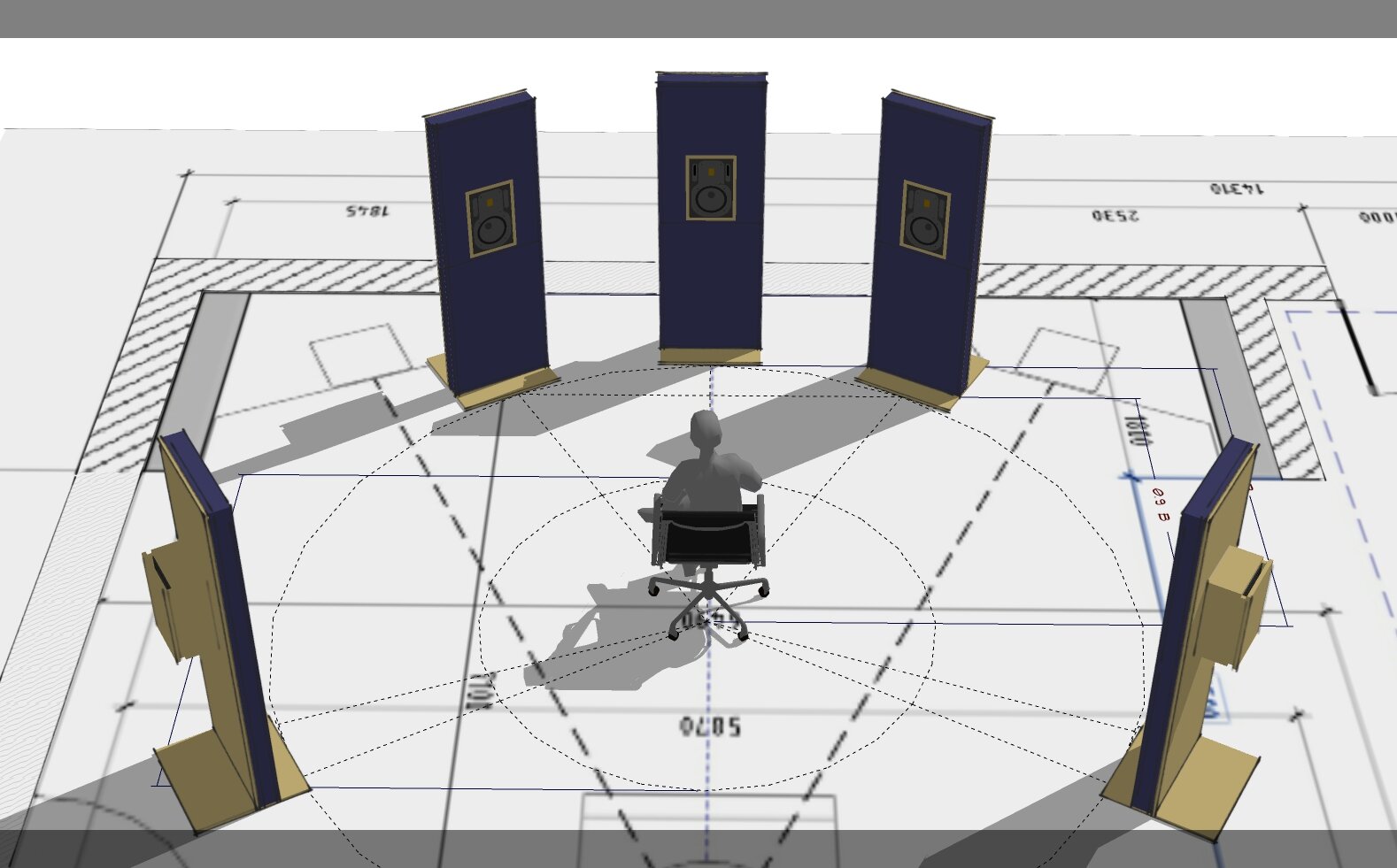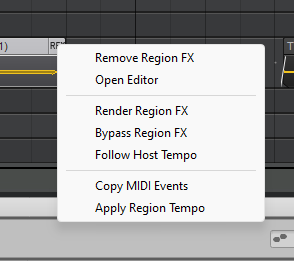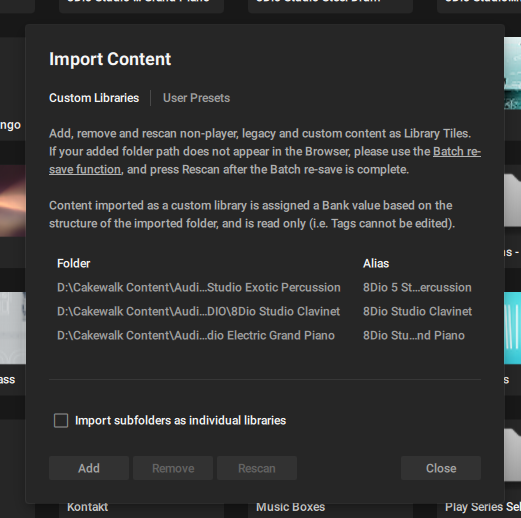-
Posts
1,719 -
Joined
-
Last visited
Everything posted by Glenn Stanton
-

CAL Script to change Event Type
Glenn Stanton replied to Giuliano Cocco's topic in Cakewalk by BandLab
-

CAL Script to change Event Type
Glenn Stanton replied to Giuliano Cocco's topic in Cakewalk by BandLab
the event kind is read-only. if you need to "change" an event kind to something else, you could create a new one of the desired event kind, assigning whatever value made sense, then delete the one you found (or leave it). in essence - you're replacing the event kind you want to change with a new one of the kind you want 🙂 -

EZdrummer 3 vs. Addicitve Drums 2
Glenn Stanton replied to bmarlowe's topic in Instruments & Effects
one more note: on the EZD - exporting a track to audio - you have options for single file (select 24-bit for best audio imho) and there is a mixer option for multiple files where you can assign the individual (mostly) drums to a separate (or combined) output. in general, keeping the mix mode into stereo when creating the performance, and "rough mix" export, followed by the "stem" output will give a lot of options. if you're not exporting, then just open it with either a first audio output or if you want more control - all available outputs. SD3 is a huge (ships with it's own SSD!) and super flexible system. -
so @John Vere, you're saying you broke the Internet? LOL 😉
-

Cakewalk by BandLab praised as best free DAW (for now)
Glenn Stanton replied to Starship Krupa's topic in Cakewalk by BandLab
i dunno, i think except for the DX basis (old API and some potential for timing issues), and the lack of audio "flavoring", the Sonitus Compressor is a nice lightweight utilitarian plugin with side chaining and enough settings to handle most basic compressor tasks. between the gate, compressor and multiband compressor, fairly decent set of free plugins w. perhaps a fix for the DX issues and scalable UI. -

EZdrummer 3 vs. Addicitve Drums 2
Glenn Stanton replied to bmarlowe's topic in Instruments & Effects
+1 on AD2 vs EZD3. i use the EZD (sometimes but not often) to create the parts but mostly use the AD2 to render as the EZ stuff (all of them really) are overly processed, and a lot of it seems baked in, even after turning off effects. so it's hard (for me) to get the EZ audio where i want, whereas the AD2 i can turn off the processing and have the raw samples (if i need them raw versus the various level of kit preset processing). i will note that the EZD3 does let you substitute a simple sample on each instrument fairly easily which can be handy, but will not have the same set of dynamics their built-in samples have. and i don't have time to really tinker with it... -
it's not the size that matters. um, well for some things it does 😉 , but more the concern should be: what happens if the disk breaks down or something in the complex microelectronics or software does something wrong? corruption on large storage systems is certainly possible when using single hard disks and SSD. so it might not matter until a bunch of old nff files somehow get mixed into your latest client delivery files during a disk optimize process or simply bad sectors and memory leaks resulting in bad writes, or power outage causing write caching to do the wrong thing -- resulting in many hours of clean up and recovery or worse sharing them in that condition. nothing wrong with an old workflow which keeps extraneous files cleaned up and projects etc backed up and recoverable.
-
they probably ran into support issues where too many custom configurations on the cache were eating up support folks time, dunno. just guessing, but it would be nice to restore the custom folder setting as well as default to the project folder when an ARA call is made so the project & cache are in the same location. might be something CW stopped supporting - i.e. passing the folder, or even possible Steinberg said no more folder name passing in VST3 LOL 🙂
-
for me - Melodyne seems the be the main one but i've found some of the Arturia products generate tmp files when you're tweaking settings, but i remove them as part of the content sync i do to the cloud disk periodically. my studio design work has several products which do spin-up temp files, the main one is my rendering engine Podium. so i just clean that one periodically as well (from a quick access link). i could imagine though, if you have an audio editor (like RX, SoundForge, Acon, etc) which launches from CW, i would presume there is some caching. for me, if i need to edit an audio file that is used within CW, i usually open the file in the editor directly.
-
the only problem is the documents path - is if it is the OneDrive (personal) documents folder - the reason i added the junction - i was seeing my OneDrive backing up separation files as i was working on them, and i suspect that could have caused a crash or two. since the OneDrive doesn't seem to follow a junction link, the separations on my project folder no longer risk contention from the cloud service. as W11 has been pretty stable, most times i didn't go through my usually process of pausing Google and OneDrive and setting airplane mode on. and since Celemony changed the option to get the cache path, the junction solved the issues (as well as getting dynamic project content off my C drive).
-
the option to edit the file path for the cache seems have been blocked at some point in v5, but i created a directory junction (using "mklink /J") to redirect it from the OneDrive documents folder to the project drive Melodyne folder (like i had it before they changed it). so far, so good.
-
and depending on where you are located, you might even rent a few mics to try them out. one last comment from me - consider as a backup mic a Behringer B2 Pro. inexpensive but i've had a number of singers who i've done sound for live, and recording, praise it before they knew it was one of those "B" products LOL. weird. but worth also checking.
-
i have several - synth-weight M-Audio Keystation 49 (sits in the "keyboard" draw of my desk), a Komplete Kontrol S49 MkII Pro (which has a semi-weighted feel) and i use it with the Komplete Kontrol app so i can simply play around switching up my libraries to get ideas. and my preferred one: Kurzweil 88 stage piano which has properly weighted keys and some nice built-in sounds but mainly it's used for MIDI. like Roland and a few others, it's heavy duty, replaceable parts, as well as highly maintainable. i have an older Roland 88 (weights about 90lb) but many keys are busted up (lent to someone who kind of beat it up), and it really needs a whole new set of keys (~$300), however, to replace them looks pretty easy as they're all on a long rod that they can slide off and back on to. so my son has it as a project 🙂 a properly sized 61, 76, or 88 key should have sufficient width on the keys (they generally mirror the key sizes on a regular piano), whereas the smaller # of keys then to shrink them all a bit. the MIDI controllers are nice but require something to play with, whereas a keyboard with sounds & MIDI can be useful for quick access for writing (without firing up an audio app). and budget-wise figure $150 on the low end (like the M-Audio) and up to a few thousand $ (like a Nord etc).
-
which, on longer or offset clips read "RF" 🙂 and left clicking (assuming that's your button configuration) let's you easily select Copy MIDI and remove/render etc... this let's you quickly step through and render them...
-

Band in a Box share you thoughts!
Glenn Stanton replied to John Vere's topic in Instruments & Effects
as a note: i purchased some of Bob's expanded styles (circa 2012?) because i needed more advanced time signatures and really did not have the patience to do the silly 4/4, 3/4 mixing of bars. very nice and quality work for a reasonable price. -

[SOLVED] Kontakt 5 Says Library Folders Are Invalid
Glenn Stanton replied to sjoens's topic in Instruments & Effects
the "libraries" are usually installed via the NI Native Access app and you configures folder etc there. in Kontakt itself, same configuration for folders. adding custom "libraries" (really instrument folders) you can go to the library page and import content (lower left gear). if the folder list is correct, then rescan each. did you have any directory junctions that maybe are now missing? -
depends on the drum track you create in EZD (or really any other tool like EZK and EZB, the Ample series of instruments w/ their Riff section, Scaler, etc etc) the idea is whatever is the length you need for a given section of song divide that by the phrases you need. e.g. i have a verse of 12 measures, and 3 separate drum phrases, so i create a 12 measure track in EZD, create those phrases, then drag that into my MIDI track. then repeat for chorus etc. then either copy those clips into the rest of the song (or use the arrangement tool in CW) to fill it in. for simpler phrases / song structures, the groove clip approach is viable. often times i'll stretch it for the length needed, then bounce to clip to eliminate the looping, and then edit parts to mix it up a bit (crashes, splashes, flams, some tom hits, etc etc).
-
sheesh, i thought everyone knew these the real fun begins when you fat finger it in lieu of the alt or ctrl keys... let mayhem reign!
-
that way, beyond the simple captcha, you need some intermediate steps like email verification + profile update - two things not done in the sign up. then post limiting. again the idea is increase the expense of the attack while making cleanup easier. obvious stuff like filtering for garbage thread names (like we see here with lots of extraneous characters typical users would not use). and infrastructure - single session per account regardless of device. this last one prevents many different devices, paths, etc using the same account to spam in an effort to bypass the authentication and manual steps and limited posting.
-
no i don't think you need to go that far once you have the initial authentication and profile update steps. then simply limiting the number of initial threads and replies will enable basic help and let the moderators cleanup spam threads and related reposts. having multifactor authentication on every login would be painful and not really needed for this venue.
-
security is more than simply setting controls - you need process as well. authentication of the user and time/posting limits initially. so if you need to reply to an email or text message with the verification code before signing in, and then some profile updates. these two steps are not a hardship for real people but for spammers and bots it has a cost to get around - time, effort, and/or money to program, hire spam teams etc. and limit to 2 topic posts in the first 24 hours w/ reply restricted to those topics. infrastructure (hardware and software) can be used to reduce session re-use in spamming and other attacks. for example, you're login is a singleton which applies to all other activity on the site, multiple logins even from different devices do not count as anything other than 1. 🙂 an example is gmail - i can login in from multiple devices but the session is effectively 1 session for all devices. this way real people can ask for help and respond without limiting them too much. no one should really need to have more than 2 topics initially. then after the post, a minimum 1 reply to a given topic (presumably after someone else has responded, it's not a copy or high % copy of the first post, and there is no "bump" post until after say 4 hours), then can now be given access to post 2 more topics etc and after then after the posting of those 4 topics and minimum 1 reply (like "thanks") to a response on their thread, you can free them from initial "jail" and become proper members. heuristics matter. then removing spam topics is lower cost to the business. no true way to stop all attacks but you can make it more costly to the attackers. secondly if those spammers are using real businesses and/or products in the spam, feel free to have your legal folks (or a friend who has mastered properly scary language) to drop them a note about the reporting to government agencies and pending legal jeopardy. just in case the business actually didn't hire the spammers. those who care may take an interest in helping to stop it.
-
sure they don't log it... pretty sure many (esp EU or any echelon member states) require it to do business in their country. i love the TV shows where they cannot trace the information. of course they can. now if you want untraceable (but unreliable) then using non-TCP/IP protocols is the way to go although a lot of routers block those, using command protocols to signal get around a lot of that.
-

Band in a Box share you thoughts!
Glenn Stanton replied to John Vere's topic in Instruments & Effects
i mainly use it to find alternatives to a given song - for instance ALL country songs and ALL reggae songs are 100% interchangeable. if you take a country song and swap the style to reggae or vice versa, 100% fit. every. single. time. 🙂 so a few older numbers i created originally as country songs became reggae because of this phenomena... nowadays i use it to generate some solos like sax where my sax playing skills are, erm, limited. very limited. but you need to spend time going through the different "players" and you need to select a style for the song (as well as tempo and arrangement etc) to finally get to a decent solo that doesn't sound "canned" (or too canned - not the bird). i have had the middle tier of the options for 20+ years now and there are some electronic style (mostly MIDI) which could be useful (if i did those). and it would be nice to get the MIDI from the real tracks because some of the sounds have too much "enhancement" (reverb, distortion, over compression etc) and would be nice to replace or augment easier than Melodyne or drum replacer etc. so -- for BAIB - start simply - enter chords, pick a style, set the tempo, repeats and let it rip. you can get quite far using those, and if you feel the need to tinker, beware... the tinkerer elves were the inventors of this product and it's a deep and wide rabbit hole which may consume more time than is worthwhile. but for learning to build up songs and arranging (like using the various . notation and the ^ lead-in notation) it's useful. for better options on learning to create songs with a lot more flexibility - consider looking into Hookpad. $5/month. http://hookpad.hooktheory.com best $5/month imho. the exported MIDI is generally good, and tons of options as well as a learning tool which is interoperable with the Hooktheory site (i use the free version of that) and a great library of tunes, progressions, and an excellent forum for getting help and discussions on music theory etc (which is imho a better investment in learning music than tinkering with BIAB). -
you might own it, but you need to prove it. hence the copyright filing which makes it official. depending on timestamps, self-address sealed postage-marked envelopes, etc have varying degrees of success in proving ownership. the article implies that basically someone streams your material off whatever service you use, relabels it and then puts it up on a paid-per-listen(s) service and subsequently then uses bots to play them over and over in order to get royalties. i'm guessing the 40 second noise thing is something the main services can filter most of them out. and as they decide the get smarter about the IP address or device/account used (like you cannot be in the US and EU at the same time, regardless of TCP/IP routing...) they'll block the bots more and more. until the bot programmers come up with something like, likely hacking people phones/tv sticks/laptops etc to play (silently) using your own personal devices








